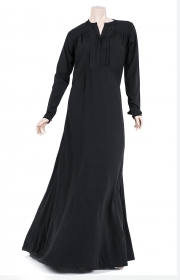Lifestyle
The Untold History Of Abayas

Introduction
The abaya is a traditional outfit that is black in color and resembles a robe. It is usually worn by Muslim women in order to cover their body and clothing. In simple words an abaya is a long-sleeve dress that is loose fitted like a robe and is traditionally worn in many Muslim countries like Saudia Arabia.
Abaya is known as different names in different countries. In countries like India and Pakistan it is known as a burkha while it is usually called a chador in Iran. In addition to the name, the cuts, designs and patterns of abayas also differ from region to region; however, the main purpose remains the same.
The abaya covers most part of the body excluding the hands, feet and face. However, in order to do so gloves, niqab (a veil) and socks may be worn, but these are not considered a part of the traditional abaya.
History
 The history of abaya is not very well documented. Most experts believe that it existed more than 4000 years ago in the civilization of Mesopotamia. This was the time when Islam arose rapidly in the seventh century C.E.
The history of abaya is not very well documented. Most experts believe that it existed more than 4000 years ago in the civilization of Mesopotamia. This was the time when Islam arose rapidly in the seventh century C.E.
It is believed that during those times women did not use to wear clothes for covering. They usually wore clothes that revealed their body parts including their breasts.
Many are of the idea that this was done due to the desert heat as they could not afford to get their bodies covered.
However, this started to change when Muslims arrived in the region and brought their own ideologies that made women cover their bodies and use veils.
This was done mostly to protect women against wrongdoers and disrespectful men.
Different people looked at veiling and covering bodies in different ways. In the pre-Islamic era, urban centers of the Arabian Peninsula considered veiling as a sign of luxury and privilege given to women of certain class.
This was usually done to distinguish respectable women from prostitutes and slave girls as the latter were not allowed to wear coverings.
This is how abaya and extra coverings are believed to have been invented. However, over the years the beliefs have totally changed. Now, almost all Muslim women are allowed to wear abayas unless they are in a non-Muslim country that does not allow so.
Modern Abayas
Abayas are extremely in demand in Muslim countries due to Islamic Shari’a law dictating Muslim women to be covered in front of men they could hypothetically marry. Wearing abayas is not compulsory in the presence of blood relatives like fathers and siblings. However, due to it being a part of tradition many women wear abayas all the time irrespective of where and in front of whom they are.
In today’s world abayas come in different designs, colors and types. Thanks to people being worried about fashion, embroidered abayas are also being produced now with big fashion houses also entering the race. However, the traditional black abaya hasn’t lost its charm and is commonly seen in the Middle Eastern countries like Saudi Arabia, Qatar and Kuwait.
Featured images:
License: Image author owned
Aisha Malik: Aisha is a fashion specialist who writes for several magazines on Islamic clothing like hijab and kurtas. She likes to travel, especially to Muslim countries to see the changing fashion.
-

 Tech11 years ago
Tech11 years agoCreating An e-Commerce Website
-

 Tech11 years ago
Tech11 years agoDesign Template Guidelines For Mobile Apps
-

 Business6 years ago
Business6 years agoWhat Is AdsSupply? A Comprehensive Review
-

 Business10 years ago
Business10 years agoThe Key Types Of Brochure Printing Services
-

 Tech8 years ago
Tech8 years agoWhen To Send Your Bulk Messages?
-

 Tech5 years ago
Tech5 years ago5 Link Building Strategies You Can Apply For Local SEO
-

 Law5 years ago
Law5 years agoHow Can A Divorce Lawyer Help You Get Through Divorce?
-

 Home Improvement6 years ago
Home Improvement6 years agoHоw tо Kеер Antѕ Out оf Yоur Kitсhеn































